Woodyard D. (ed.) Pounders Marine diesel engines and Gas Turbines
Подождите немного. Документ загружается.


The camshaft-shifting facility is optional; a simpler design is specified for
engines whose projected operational profiles do not justify adjustable injection
timing. Retrofitting of the facility is possible at a later date, however, if service
conditions dictate.
The valve actuating camshaft is provided with different cams for full-
load and part-load engine operation, allowing valve timing to be tailored
optimally to the conditions. As with a reversible engine, the camshaft can
32/40 engine 587
Figure 22.18 L32/40 engine; note the separate camshafts for fuel injection and
valve actuation, respectively, on the left and right sides of this cross-section

588 Man Diesel
be shifted from one final position to the other to engage the two different
cam configurations. Shifting is performed with the engine running. The load
point at which switchover from one cam contour to the other takes place can
be pre-set as required via the control system of the shifting mechanism (see
Chapter 16/Figure 16.3).
Load-dependent adaptation of valve timing promotes low pollutant com-
bustion in both high- and part-load operating modes. Clean combustion with
little emission of soot particles is reportedly secured over the full-load range.
The valve camshaft-shifting facility—like its fuel injection counterpart—is
an optional device: the standard engine version features just one cam contour.
The conversion to an adjustable system for the charge renewal side, however,
can be effected at a later date. Independent camshafts, along with the ability
to fine-tune the timing and fuel pumps, reportedly underwrite almost constant
firing pressures over the 85–100 per cent rating range, optimized performance
down to partial loads and the ability temporarily to handle fuels with poor igni-
tion qualities. Efficient operation on low-grade fuels with viscosities of up to
700 cSt is also fostered. An optimized cam- and camshaft-shifting facility on
the fuel injection side allows IMO requirements on NOx emission levels to be
met; and changeover from open sea to coastal and harbour service (from fuel-
optimized to emissions-optimized/SOx-reduced operating mode) is relatively
simple.
The 32/40 design is based on a very stiff-cast monobloc single-part frame
which is suitable for direct resilient mounting or semi-resilient mounting of the
engine, with individual cylinder jackets as well as through bolts for the main
bearings and lengthened cylinder cover bolts: a principle applied first in the
58/64 and subsequently in the 40/54 and 48/60 engines. The concept was mod-
ified for the smaller bore engine (Figure 22.20).
Individual cylinder jackets allow the geometry of the cylinder liner to be
maintained under all load conditions, avoiding disturbing influences from
neighbouring cylinders. The main bearing through bolts and the cylinder cover
Figure 22.19 an L32/40 engine camshaft arranged for adjustment of fuel injection
timing
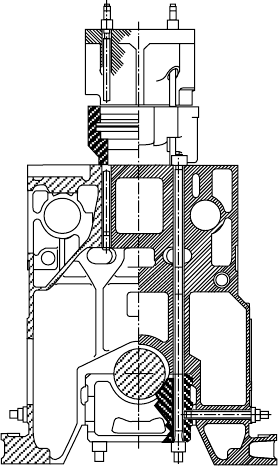
bolts extending to the middle frame range place the engine frame under com-
pressive pre-stress, promoting high component reliability despite the high fir-
ing pressures.
The mounting arrangement of the cylinder liner in the jacket and engine
frame is shown (Figure 22.21). Cooling water is supplied to the cylinder
jackets only; none circulates in the engine frame structure, eliminating the
risk of corrosion and water penetration of the lubricating oil. Individual cyl-
inder jackets foster low distortion of the thick-walled laser-hardened liners. A
uniform temperature pattern over the entire liner surface is reportedly secured
through intensive cooling by a special water feed in its upper area.
A separate fire ring (anti-polishing or carbon cutting ring) for the liner
in association with an appropriately stepped piston inhibits the formation of
combustion residue deposits on the liner; liner surface polishing is thereby pre-
vented and low lubricating oil consumption promoted. The fire ring features jet
bore cooling like the previous one-piece liner design. Experience has shown
that removing the ring—necessary for piston withdrawal—can be carried out
quite easily with the simple tools provided.
A four-bolt cylinder cover was designed relatively deep to ensure an excel-
lent flow of power from the nut contact faces of the cover bolts to the seal
between the cylinder head and the liner, as well as a very uniform distribution
of pressure at the circumference of this seat face (Figure 22.22). The charge
air and exhaust lines are arranged on opposite sides of the cover, the cylin-
der head depth allowing the flow ducts to be configured to enhance the overall
32/40 engine 589
Figure 22.20 L32/40 engine frame
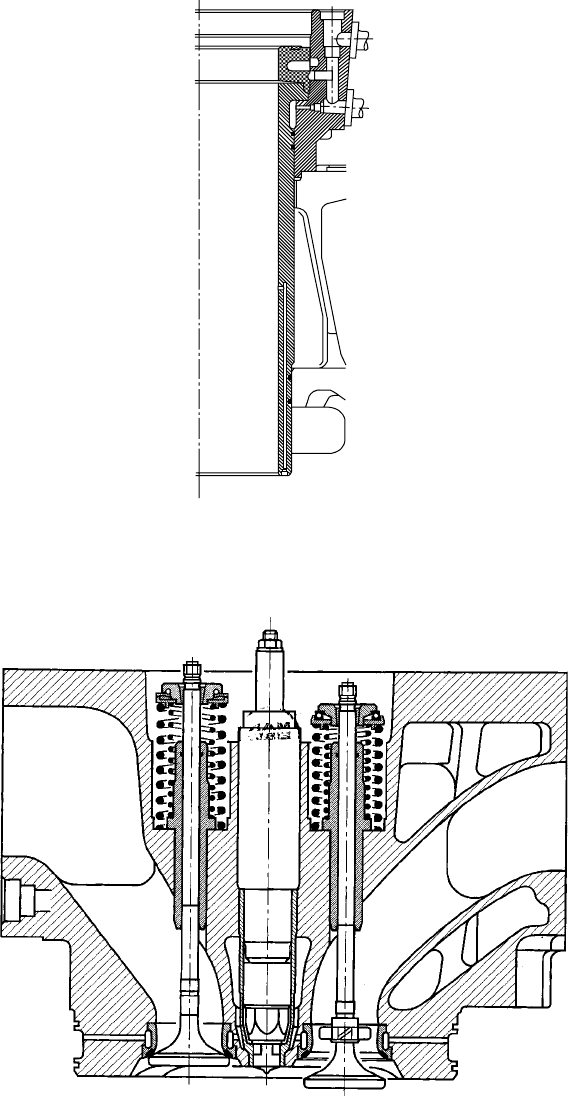
590 Man Diesel
Figure 22.21 L32/40 engine cylinder liner section; note the ame ring mounted on
the top
Figure 22.22 L32/40 cylinder head
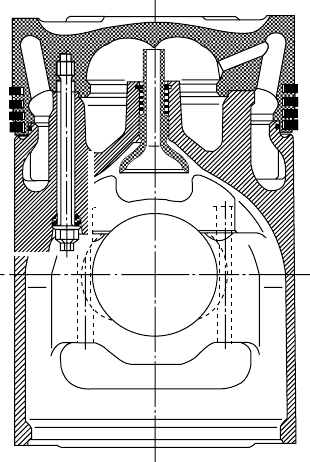
efficiency of the turbocharging system. A bore-cooled flame deck yields low
temperatures at the combustion chamber side and a high mechanical strength
permitting the high firing pressures to be absorbed with a good safety margin.
Valve cages were omitted. Both exhaust and inlet valves are accommodated
in cooled seat rings, the exhaust valves featuring a rotator with a gas-driven
propeller vane at the valve stem. The cylinder head, rocker arm casing and a
section of the charge air manifold form a unit for maintenance purposes which
can be dismantled as a whole when a piston has to be withdrawn.
The composite piston, similar to 40/54 and 48/60 engine practice, consists
of a nodular cast iron skirt topped by a forged steel crown whose diameter is
reduced in way of the top land to match the fire ring (Figure 22.23). The crown
is cooled by the cocktail shaker method (splash effect) in its inner and outer
areas, the latter also served by bore cooling. The configuration of the cooling
chambers ensures a good shaking effect with the cooling oil supplied via the
connecting rod.
Chromium/ceramic coatings for the top piston ring and chromium-plated
second and third rings are specified to contribute to ring time-between-over-
hauls of 2 years or more. A nodular cast iron skirt allows a smaller clearance
with the rigid liner to be adopted compared with aluminium, this creating
favourable preconditions for piston ring running behaviour.
Smaller overall dimensions and more restricted space in the crankcase of
the 32/40 engine precluded the use of the connecting rod design used in the
larger members of the MAN medium-speed family which features a joint in
32/40 engine 591
Figure 22.23 L32/40 engine composite piston
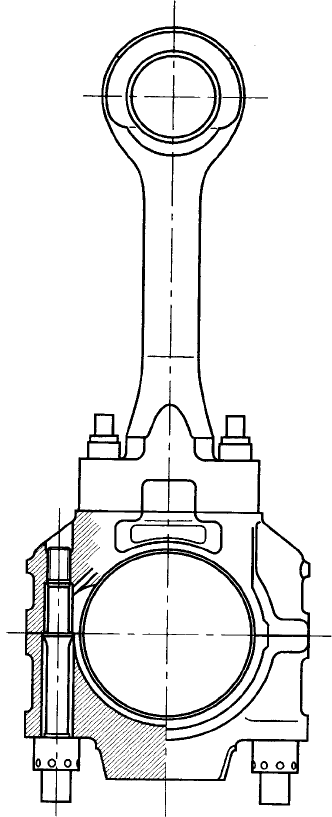
592 Man Diesel
the upper part of the shank. The traditional marine head design was there-
fore adopted, with a joint arranged just above the big end bearing box (Figure
22.24). No drawback is suffered with respect to the required headroom for pis-
ton withdrawal since the distance between the four cylinder cover bolts is suf-
ficient for the connecting rod shank to pass without difficulty.
Design and material specifications of other key wearing components target
extended lifetimes and maintenance intervals of at least 2 years for the liners
and exhaust valves. A very low wear rate of the valves is promised from the
Figure 22.24 The L32/40 engine connecting rod is a traditional marine head design
armoured seats and directly water-cooled seat rings. A clean gas-tight seat is
maintained by the exhaust valve rotator.
The designer asserts that constant pressure turbocharging is based on an
MAN uncooled turbocharger which, along with the charge air and exhaust gas
ducting arrangements, promotes a positive charge renewal performance and
hence fuel economy. MAN NR26 or NR34 radial-flow turbochargers were
typically specified for all cylinder number versions of the engine. Streamlined
transitions from the cylinder heads to the exhaust gas line, as well as the double
diffuser arranged downstream of the compressor, help to keep pressure losses
in the exhaust gas system at a low level; and part of the kinetic energy of the
charge air leaving the compressor at high speed is transformed into pressure
on the air side. Both properties contribute to a substantial increase in overall
efficiency.
If an engine’s load profile dictates, warm charge air can be withdrawn
directly after the compressor and supplied to the last section of the exhaust gas
line upstream of the turbine via a bypass. The section is provided with a spe-
cial belt to ensure perfect mixing of the bypassed air with the exhaust gas; a
relief valve can also be fitted in the belt if required.
The charge air cooler can be of the single-stage or two-stage type. The lat-
ter is specified when the heat contained in the high temperature stage is to be
exploited or if, in the case of frequent part-load operation, the charge air is to
be preheated by the engine cooling water in the lower load range to ensure
favourable combustion conditions.
Ease of inspection and overhaul—a focus of medium-speed engine design-
ers in an era of low manning—is addressed by the four-bolt cylinder cover
with quick-acting seals and clamped and plug-in pipe connections. Only two
different types of hydraulic tools are required to handle all the main screwed
connections on the engine. The marine-type crankpin bearings allow the con-
necting rod to be withdrawn up the bore for piston and ring inspection without
disturbing the bearings. The exhaust gas line features quick-release couplings
that permit swift disconnection from the cylinder head.
MAN Diesel originally anticipated a 550 man-hour annual maintenance
workload for an eight-cylinder L32/40 engine running for 6000 h on heavy fuel.
The basic regular jobs are: replacing the fuel nozzles every 3000 h; overhauling
the exhaust valves (removing the cylinder cover) every 6000 h and overhaul-
ing the piston (including the replacement of rings and honing the liner) every
12 000 h. Service lives and maintenance intervals for the key components of
current 32/40 engines are indicated in Table 22.2.
32/40 engine renements
Continual development of the 32/40 engine has pursued reductions in smoke
emissions throughout the operating range without undermining fuel economy,
easier maintenance and improved flexibility in setting the engine’s parameters
for specific projects. Many components were modified in meeting these goals,
32/40 engine 593
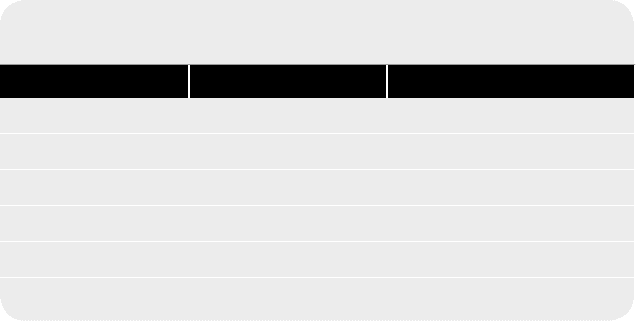
594 Man Diesel
such as the cylinder head, fire ring, support ring, rocker arms, valve cones, pis-
tons, camshaft and gas exchange cams. Improved efficiency, particularly at loads
less than 50 per cent, was gained from a modified MAN NR-type turbocharger.
Measures to enhance emission values included a new injection nozzle
design with a smaller sac volume minimizing the amount of fuel sprayed into
the cylinder after the needle is closed. The benefits are reduced dripping and
hence reduced smoke formation. A new cylinder head design incorporates an
improved combustion chamber geometry promoting unhindered atomization
of the fuel jets. The fuel injection pressure was also increased from its base of
1350 bar, and closing of the injection needle improved.
Efforts were also directed at reducing engine cost and weight, and facilitat-
ing maintenance. A redesigned rocker arm casing, for example, is lighter and
allows faster nozzle replacement. A new steel piston was released in 2001. The
lubricating oil and cooling water systems were combined into a single unit—
the frame auxiliary box—to create a compact, vibration-free package calling
for reduced piping.
48/60B engine
The 48/60 engine was originally introduced to series production in 1989 with
a rating of 885 kW/cylinder, which was progressively increased to 1050 kW/
cylinder. Further development of the 48/60 design was stimulated by the
higher propulsion power demands of cruise ships, ferries and large multi-pur-
pose cargo ships, as well as stricter environmental standards. The resulting
B-version was launched in 2002 with a 14 per cent rise in specific output to
1200 kW/cylinder at 500/514 rev/min from a lighter and more compact design.
The 48/60B programme spans a power band from 7200 kW to 21 600 kW with
six, seven, eight and nine in-line and V12, 14, 16 and 18-cylinder models. The
V-cylinder engines were released first, with the in-line models planned to fol-
low in 2003 (Figure 22.25).
Table 22.2 Service lives and maintenance intervals for 32/40 engine
components
Component
Service Life (
1000 h) Maintenance interval (1000 h)
Cylinder liner 80–100 15–20
Piston crown 60–80 30–40
First piston ring 15–20 –
inlet valve cone 30–40 15–20
exhaust valve cone 30–40 15–20
Fuel injection nozzle 6–10 3
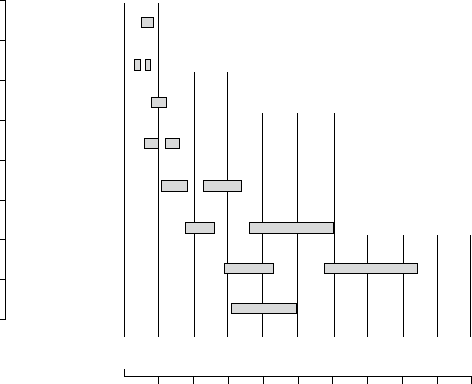
Retaining the original 480 mm bore/600 mm stroke dimensions, the design-
ers aimed to: reduce fuel consumption; optimize combustion with a view to
reducing NOx and soot emissions; boost the specific power output; reduce
engine width; lower engine weight; optimize a range of engine components
including the big end bearing; and reduce the overall number of engine com-
ponents. Easier maintenance, higher reliability and lower manufacturing costs
were also pursued. The goals were achieved by developing new sub-assemblies
and/or improving components.
Combustion benefited from: a simplified exhaust gas system with only one
manifold and only one turbocharger on the V-cylinder engine; a redesigned
combustion space; a new fuel injection system with high injection intensity;
modified valve timings; and the new MAN TCA-series turbocharger (see
Chapter 7). The compression ratio was increased from 14.4 to 15.3, a rise
facilitated by a combustion space optimized by avoiding dead volumes, edges
and ribs in the combustion side of the cylinder cover. The fuel injection pres-
sure was increased from 1300 bar to 1600 bar, the higher intensity helping to
reduce visible flue gas emissions, particularly in the part-load range. Higher
NOx emissions were neutralized by slightly delayed injection timing.
A significant contribution to fuel economy came from the new MAN
TCA77 turbocharger through an increased flow rate and an efficiency rise
of 8–10 per cent (Figure 22.26). The minimum specific fuel consumption of
173 g/kW h (for the V-engine at 85 per cent maximum continuous rating) is
48/60B engine 595
0
5 000 10 000 15 000 20 000 25 000
kW*available mid-2003
rev/min
1000
800–900
800
775
720–750
500–600
500–514
400–428
L21/31
L23/30A V23/30A
L27/38
L28/32A V28/32A
L32/40 V32/40
L40/54 V40/50
L48/60B* V48/60B
L58/64
Figure 22.25 Man medium-speed propulsion engine programme before the intro-
duction of common rail (Cr) fuel injection versions; the L40/54 and V40/50 series
have since been dropped
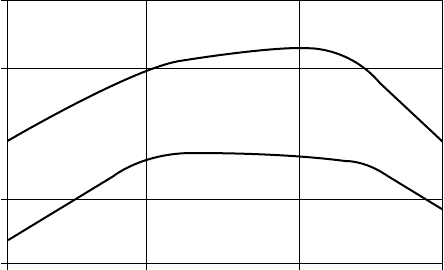
596 Man Diesel
7 g/kW h less than that of the original 48/60 design, while the emission values
on the IMO NOx test cycle are 8 per cent less at 12 g/kW h (Figure 22.27).
Accompanying the higher output, fuel economy and environmental friend-
liness is a lower specific engine weight (reduced by 16 per cent to 11.9 kg/kW).
The V12-cylinder 48/60B model, for example, develops 14 400 kW and weighs
181 tons, while its predecessor yields 12 600 kW from a weight of 193 tons.
For the V18-cylinder engines, the reduction in weight is approximately 15 tons
and the extra power around 2700 kW. The dimensions were also reduced: the
height remains the same but the B-engine is 800 mm (15 per cent) narrower,
thanks to a new exhaust system concept. A pair of 48/60B engines can thus be
mounted closer together than before, giving an installation width saving of 1 m.
The turbocharger and two charge air coolers were combined to form a single
module on the V-engine.
Internal refinements included an improved piston, with steel crown and
nodular cast iron (or steel, if preferred) skirt. The cylinder head incorporates a
re-shaped combustion chamber, no valve cages, an innovative rocker arm con-
cept and a modified rocker arm cover. The connecting rod shank features opti-
mized bearing shells, an increased oil clearance, reduced rotating masses and a
strengthened bearing cover design.
Among the elements retained from the original design, with proven reli-
ability in heavy fuel operation, were the stepped piston with chrome-ceramic
first ring; exhaust valve with propeller (to ensure a clean and gas-tight seat)
and MAN’s constant pressure charging system with exhaust gas wasting and
bypass control.
Invisible Smoke (IS) variants of the 48/60 became available in early
2001 incorporating measures to achieve low Bosch smoke figures throughout
the load range. The development was stimulated by requirements imposed
on cruise ships in environmentally sensitive regions such as Alaska. The
25 50 75 100
Load %
48/60
2 × NA 40
1 × TCA 77
Turbocharger comparison
75
70
65
60
55
µTC %
48/60 B
Figure 22.26 Comparison of turbocharger eciencies: the Man TCa77 on the
12V48/60B engine and the Man na40 on the original 12V48/60 engine
